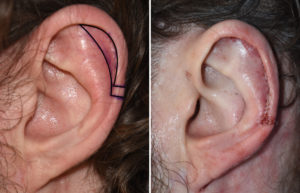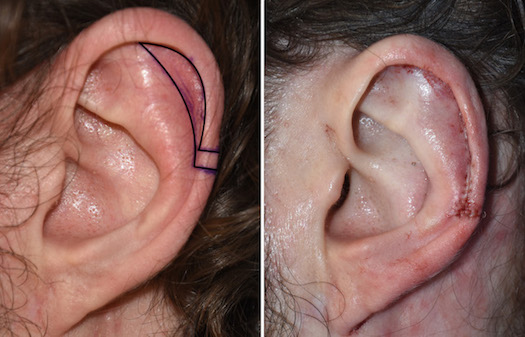Background: Aesthetic ear reshaping is most commonly perceived as the reduction of prominent ears. And while a setback otoplasty may be one of the most common aesthetic ear surgeries it is far from the only one. The convoluted shape of the large ear cartilage and the inferior hanging cartilage-free earlobe make for a variety of shape change procedures.
One of the least appreciated ear reshaping surgeries is that of macrotia reduction or the shortening of a long ear. There are two methods for reducing a large ear and they are often done together for maximal effect. The top half of the ear can be reduced by a superiorly-based or inferiorly-based scaphal flap which removes 5 to 7mms of height through cartilage and skin excision. Inferiorly the earlobe can also be reduced by an equal amount through a rim reduction method. When done together it is easy to see that at least10 to 12mm of vertical ear height can be achieved.
In vertical ear reduction the skin on the back of the ear is incision free to maintain blood supply to the superior ear tissues with the skin and cartilage removed. But this does not mean that other ear reshaping like a setback otoplasty can not be concurrently done. With a postauricular incision well below that of the scapha setback techniques can be safely done. As an ear that is vertically longer looks more so if it also sticks out.
Case Study: This male wanted to setback the protruding middle part of his ear but also wanted to reduce its height. To achieve these changes an initial mid-postauricular incision as made halfway between the helical rim and the postauricular sulcus. Through this incision the concha was scored to weaken it and multiple concha-mastoid sutures placed to reduce the middle ear protrusion.

These two ear reshaping procedures can be safely done together because their incisions are not overlapping. They are at two different locations on the front and back of the ear.
Case Highlights:
1) A vertically long or large ear (macrotia) can be reduced through an intra-auricular scapula flap technique.
2) Vertical ear reduction can be combined with a variety of other ear reshaping techniques.
3) Vertical ear reduction can be thought of as either a high, low or combined high and low reduction method.
Dr. Barry Eppley
Indianapolis, Indiana




